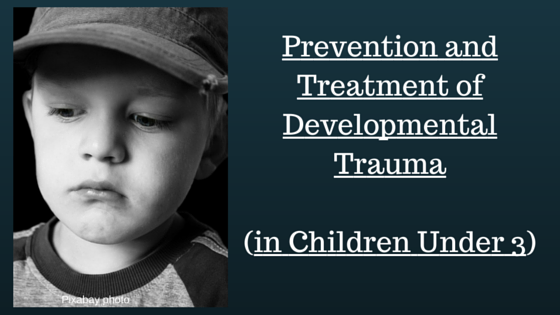What happens when an infant or toddler suffers a failure of secure attachment to his or her caregiver? What if a parent is unavailable, unsafe, or overbearing?
The science shows that developmental trauma during the first three years of life can seriously disrupt neurological, cognitive, and psychological development and attachment to parents, guardians, or caregivers for the long term.
What can be done for a child in those first few years of life, that ideally would have provided them with a solid foundation of security, identity, relational confidence, and self-regulation?
Better yet, what can be done to prevent this developmental trauma from happening in the first place?
Key principles for prevention of developmental trauma:
1. Nurture and support a child when they become emotionally upset.
Comfort should not be withheld from a child. Soft-spoken, eye-to-eye reassurance should be commonplace and is encouraged. Skin-to-skin contact and cuddling, holding and rocking are crucial. Both appropriate soothing and attendance to a child’s needs help the child learn to self-regulate.
2. Be sure your response to a young child is rapid.
Respond as quickly as possible to a child’s needs and emotions. Diligently restoring the connection between the child and caregiver without delay teaches relational cause-and-effect thinking. Children begin to see that the response by their caregiver comes with their own verbal and nonverbal communication and action.
3. Minimize adverse childhood events (ACEs) for children and caregivers.
ACEs, according to the Centers for Disease Control are “potentially traumatic events that can have negative, lasting effects on health and wellbeing.” The idea is to put into place interventions early enough to prevent childhood trauma and mitigate unaddressed trauma sustained in the parent’s childhood. By developing resilience in children and families, fewer children will suffer early on and later in life.
4. Create healthy environments for the whole family.
Children will be best served by safe, responsive families, home environments, and communities. Full family support is ideal. In recent years, the American Academy of Pediatrics has been developing a network of services that allows for care, education, family support services, and private community outreach that sustains the general health of the entire family unit.
Key principles for the treatment of developmental trauma:
1. Manage traumatic reenactments.
Developmental trauma is firmly imprinted on the mind and may play out repeatedly in a child’s behavior, thinking patterns, or responses. It is vital that the child’s tendency to repeat trauma is recognized, put in perspective, and understood in context. Treatment should consider that the traumatized child will likely view the help, parameters, and instructions they are provided as unsafe and threatening because their most “safe relationships” were quite the opposite.
2. Establish safety and competence.
Developmental trauma resides in the bodies of children and remains there, making itself obvious in their habitual fight/flight/freeze reactions. Treatment will need to engage children in activities that are not trauma triggers but allow for fun and predictable task mastery. This increases the capacity for self-regulation and organized interaction.
3. Pay attention to the body.
Developmental trauma causes children to experience hyperarousal and numbing deeply. Relaxation is nearly impossible, and irritability may be commonplace. Employing fun, neutral tasks and physical recreation will be invaluable in providing body knowledge, a sense of physical mastery, and allowing a means for instituting relaxation techniques without being threatening.
Developmental trauma must be addressed.
We can change the sense of defeat so many children carry with them.
It’s vital that we see the hyperactivity, aggression, defiance, dysfunction, and distrust for what it is: built-in pain. Developmental trauma. With work and diligence, therapy and training, it is possible to bring peace to children and adults who have suffered too long.







Leave A Comment